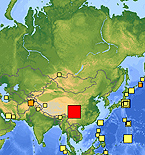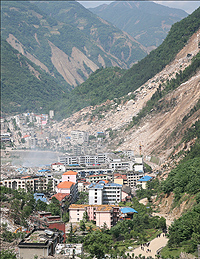Wenchuan Earthquake Mudslides Emit Greenhouse Gas
March 3, 2009

Mudslides that followed the May 12, 2008 Wenchuan, China earthquake, ranked by the U.S. Geological Survey as the 11th deadliest earthquake ever recorded, may release an amount of carbon-dioxide in upcoming decades equivalent to two percent of current annual global carbon emissions from fossil fuel combustion, a new study shows.
Mudslides wipe away plants and topsoil, depleting terrain of nutrients for plant growth and burying swaths of vegetation. Buried vegetable matter decomposes and releases carbon dioxide and other gases to the atmosphere.
The expected carbon dioxide release from the mudslides following the Wenchuan earthquake is similar to that caused by Hurricane Katrina’s plant damage, report Diandong Ren of the University of Texas at Austin and his colleagues, who used a computer model to predict the ecosystem impacts of the mudslides.
What’s more, the vegetation destruction will lead to a loss of nitrogen from the quake-devastated region’s ecosystem twice as large as the loss of that nutrient from California ecosystems because of the October 2007 wildfires there, Ren says. And, as the biomass buried by the China quake rots, 14 percent of the nitrogen will be spewed into the atmosphere as nitrous oxide, a pollutant typically released from agricultural operations, automobiles and other sources.
The team will publish its findings on 4 March 2009 in Geophysical Research Letters, a journal of the American Geophysical Union (AGU).

Although landscapes devastated by the Chinese earthquake may re-green soon, the recovery will be cosmetic, says Ren.
“From above, the area will look green in a few years, because grass grows back quickly, but the soil nutrients recover very slowly, and other kinds of plants won’t grow,” he says.
The magnitude-7.9 Wenchuan quake was followed by many aftershocks in the Sichuan Basin, an area that, because of its geological features – deep valleys enclosed by high mountains with steep slopes – is already prone to landslides. May is also the rainy season in Sichuan, and the combination of aftershocks and major precipitation events in the days following the earthquake caused severe mudslides. The avalanches killed thousands, destroyed roads and blocked rivers and access to relief, and shredded water and power stations, among other facilities. To predict ecosystem impacts of the mudslides, Ren and his collaborators applied a comprehensive computer model of landslides that incorporates several physical parameters, such as soil mechanics, root mechanical reinforcement (the root’s grip of the dirt, which mitigates erosion) and precipitation.
Ren’s model also shows that the primary mudslides following the earthquake removed large areas of nutrient-rich topsoil, leaving behind deep scars in the land that will take decades to recover, preventing the re-growth of vegetation.
The researchers write in their paper that, although being able to predict the location and timing of a mudslide is essential to mitigate its impacts, current mudslide models are not accurate enough.
“Previous approaches, which are mainly based on statistical approaches and empirical measures, have limited predictive ability of where mudslides are going to happen,” Ren says.
His model, he claims, could be applied to forecast under what circumstances a landslide would occur at a specific location. He points out this would be particularly useful for places such as Southern California, where global warming predictions call for an increase in the frequency of these events.
Ren’s co-authors include Rong Fu, University of Texas at Austin; Jiahu Wang, Hohai University (China) and University of Oklahoma; Yang Hong and Lance M. Leslie, University of Oklahoma; David J. Karoly, University of Melbourne (Australia); and Congbin Fu and Gang Huang, Chinese Academy of Sciences.
For more information about research at the Jackson School, contact J.B. Bird at jbird@jsg.utexas.edu, 512-232-9623.
